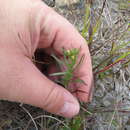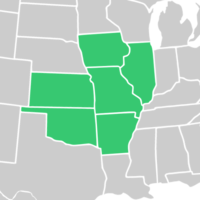Description
provided by eFloras
Perennials (sometimes short-lived), 30–100 cm, colonial or cespitose; long-rhizomatous or with short, branched caudices. Stems 1–3+, ascending to erect (straight, slender, reddish), sparsely to densely pilosulous to hirtellous, proximally glabrescent. Leaves thin, margins strigoso-ciliate to scabrous, apices mucronulate, abaxial faces glabrate to sparsely pilose and midveins ± pilose to glabrate, adaxial glabrous or glabrate to pilosulous or hirsutulous; basal withering by flowering, subpetiolate, blades oblanceolate to narrowly oblanceolate or spatulate, 10–40 × 3–7 mm, bases cuneate, sheathing, margins sparsely serrate apically, apices obtuse, mucronate, faces sparsely pilose; proximal cauline usually withering by flowering, sessile or subsessile (often with axillary clusters of small leaves), blades oblanceolate to lanceolate, 40–80 × 2–5 mm, bases cuneate, margins entire or serrulate apically; distal sessile, blades linear to subulate, 4–100 × 1–6 mm, reduced distally, bases cuneate, margins entire to weakly serrulate, faces glabrate or glabrous. Heads in narrow or wide, pyramidal, paniculiform arrays, branches ascending or arching, secondary branches (10 cm or less) secund and erect, densely leafy, heads crowded, sparsely to moderately pilose. Peduncles 3–20(–40) mm, glabrate or glabrous, bracts 3–6+, appressed or ascending, linear to subulate, 2–4 mm, scabrous, aristate, glabrous, grading into phyllaries. Involucres cylindric to cylindro-campanulate, (2.7–)3.1–4.1(–4.9) × ± 3 mm. Phyllaries in 3–5 series, appressed, subulate (outermost) to oblong-lanceolate to linear-lanceolate (inner) or linear (innermost), unequal, bases indurate 1 / 2 – 3 / 4 , margins scarious, erose, hyaline, sparsely ciliolate or not, green zones lanceolate, apices slightly spreading, often purplish, often involute, acute to acuminate or cuspidate, sometimes aristate, faces usually glabrous, sometimes glabrate. Ray florets (9–)11–17(–23); corollas usually white, seldom pink, laminae (3.7–)5–5.5(–7.3) × 0.6–1.3 mm. Disc florets 5–16(–28); corollas pale yellow becoming purplish, (2.3–)2.5–3.3(–3.7) mm, tubes shorter than narrowly funnelform throats, lobes lanceolate, 0.4–0.8 (ratio 0.25) mm. Cypselae whitish or gray, obovoid, compressed, 0.8–1.5 × 0.4–0.6 mm, 3–4-nerved, faces sparsely to moderately strigillose; pappi white, 3–4 mm. 2n = 16, 32, 48.
- license
- cc-by-nc-sa-3.0
- copyright
- Missouri Botanical Garden, 4344 Shaw Boulevard, St. Louis, MO, 63110 USA
Synonym
provided by eFloras
Aster ericoides Linnaeus var. parviceps E. S. Burgess in N. L. Britton & A. Brown, Ill. Fl. N. U.S. 3: 379. 1898; A. parviceps (E. S. Burgess) Mackenzie & Bush; A. pilosus Willdenow subsp. parviceps (E. S. Burgess) A. G. Jones
- license
- cc-by-nc-sa-3.0
- copyright
- Missouri Botanical Garden, 4344 Shaw Boulevard, St. Louis, MO, 63110 USA
Symphyotrichum parviceps: Brief Summary
provided by wikipedia EN
Symphyotrichum parviceps (formerly Aster parviceps) is a species of flowering plant in the family Asteraceae. It is native to the central United States, and is commonly known as smallhead aster or small white aster. A usually short-lived herbaceous, perennial plant, it may reach 30 to 100 centimeters (1 to 3+1⁄4 feet) in height. Its flowers have white ray florets and pale yellow then purplish disk florets.
- license
- cc-by-sa-3.0
- copyright
- Wikipedia authors and editors



